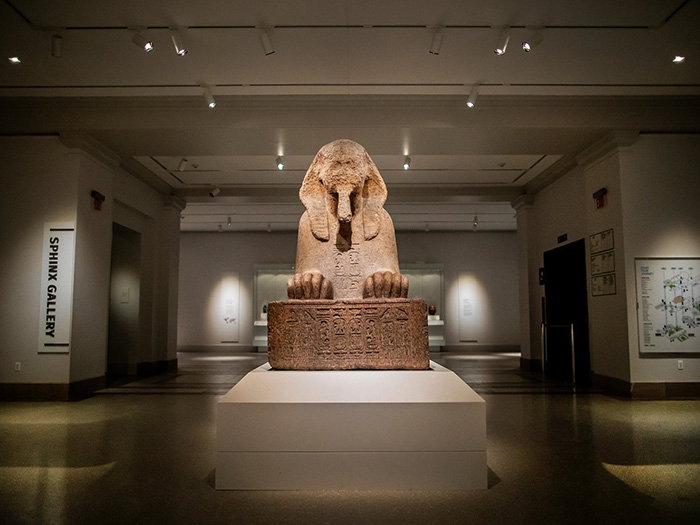Moving the Sphinx: How UPenn and Other Universities Protect Their Fine Arts Collections

One doesn’t have to venture very far onto the University of Pennsylvania’s campus before stumbling on a work of art.
Scattered around campus are outdoor sculptures: limestone guardian lions glare imposingly at the entrance to the university’s museum, a historic trolley stands alongside Woodland Walk, a life-size bronze statue of Benjamin Franklin rests on a bench. When Ben Evans, the university’s associate vice president of risk management and insurance, needs a quiet moment, he likes to retreat to a sculpture garden in the university’s Bio Ponds.
Evans undertook a number of risk management projects to protect the university’s fine art collections. He worked with the Penn Museum to relocate the 12.5-ton Sphinx of Ramses II from the Egyptian galleries to the front entrance. In 2020, as construction on the Penn Pavilion was underway, he had vibration monitors installed throughout the museum to ensure that no items were damaged as a result of construction blasts.
But Penn’s fine arts exposures don’t just lie within the walls of its museums, rare book libraries and outdoor sculpture collections. Paintings from the university’s collection decorate the walls of its hospitals. Models of famous buildings can be found in its architectural school. There are historical records of the university and the City of Philadelphia’s more than 300-year history.
“We’re not one single location,” Evans said. “We have thousands of years of history in our Penn Museum, and art is a great way of communicating history, reliving history and preserving history. Once it’s lost, it’s hard to bring back.”
With exposures spread across campus, it can be difficult for institutions of higher education to grasp the magnitude of their fine arts exposures. Many can benefit from audits to determine whether their exposures merit a dedicated fine arts insurance policy or whether there are any provenance disputes the institution should be aware of.
From Heisman Trophies to Rare Books
Perhaps the biggest hurdle to ensuring that university fine arts collections have the proper coverage is their sheer size and scope.
University fine arts collections can span multiple parts of campus, are often accessible to the public and include a variety of unique items — Heisman trophies, preserved insects and items from geological or archeological digs just to name a few. Alexandra Redfern, ACII, head of fine arts for Marsh, recalls working with one client who needed a DNA expert to match insect heads with bodies and legs after the university’s insect collection was damaged in an earthquake.
“A wonderful but challenging aspect of a university collection is that large proportions are often given by alumni, which can mean a totally unintentional curation of a variety of items,” Redfern said. “The types of collectible items are often a lot broader than people would generally expect to consider as fine art.”
Since items in university collections include donations as well as those that are intentionally curated, it can be difficult for institutions of higher education to have a grasp on their fine arts exposures. Some choose to protect their collections under their property policy, but that approach can leave items unprotected — especially those that are highly specialized.
“I think a common struggle that universities have is understanding what they have within their assets,” said Stacie Kroll, managing director, higher education practice at Gallagher.
“It goes back to them just having so many items and having had them for so long, and it’s not contained in a museum.”
To better understand their fine arts exposures, universities should do an audit of their collections. About 12 years ago, the University of Pennsylvania’s curators and collections managers set out to document every piece of art owned by the institution. They painstakingly photographed, researched and recorded each item. Evans estimates that they’ve indexed between 80 and 90% of the collection so far.
“Forget about putting a value on something — just cataloging everything is a laborious process,” Evans said.
When Universities Need a Separate Fine Arts Policy
Once universities have a grasp on their exposures, they can determine whether a fine arts policy is the best fit for them. “Fine arts are unique, they’re special and they should be in their own bucket and not lumped in with general property,” Evans said.
Specialized fine arts policies tend to offer broader coverage and lower deductibles than property policies for these exposures. Ellen Ross, managing director for Gallagher’s fine arts practice, says that fine arts policies commonly have only four exclusions: wear and tear, inherent vice, damage as the result of restoration, and war and nuclear risks.
“With property policies, some don’t cover wind, floods, earthquakes or mysterious disappearance,” she said. “Fine arts policies consistently have only those four exclusions.”
As the property market hardens or shifts, the low deductibles found in fine arts insurance may make it particularly appealing for some insureds to begin housing their exposures under a dedicated policy.
“We continue to have very good loss experience in the fine arts world and lots of capacity,” Ross said. “Most museums do have professionals to monitor and safeguard their collections. So generally speaking, these are extremely desirable risks, and risks that are easy to place.”
Specialized fine arts insurance can come in handy when university gallery directors are negotiating with alumni for donations. A donor may want the university to take on some of the insurance responsibility for their artworks in exchange for bequeathing the collection to the school upon their death. Fine arts insurance brokers can help institutions of higher education navigate these requests.
“As part of that commercial negotiation, the director may agree to take on the insurance responsibility whilst it’s still in the care, custody and control of the current family, which is something we see from time to time,” Redfern said.
“What’s really important is if you’ve got that kind of exposure, it’s declared to your insurers, because they’re underwriting the risk management of the university and how the university manages and protects its collection, which may be significantly different from a private collection.”
If a university has a minimal fine arts and specie collection, or if they choose to continue protecting their collections under a property policy, it’s important to ask questions about these items to ensure that they have sufficient coverage.
“If you don’t have a fine arts policy, work with your property underwriter to walk through how those things are covered, what’s their current valuation, how does the insurance carrier cover them?” Kroll said.
The Fine Arts Provenance Dilemma
Cataloging collections to determine whether colleges need a fine arts insurance policy can have another benefit: ensuring that universities are the rightful owners of all of their works. It can be difficult to trace the provenance of donations and gifts from decades — even centuries — ago, leaving higher education institutions vulnerable to ownership disputes.
“Institutions of higher ed have been accepting art and holding art for hundreds of years,” Kroll said. “If you’re looking back, then it makes sense to do an audit of all your files and see if there’s anything in question.”
Artworks taken from Native Americans, collected during colonization, or stolen by Nazis and later sold or gifted to universities all pose the risk of a provenance dispute, leading some institutions to return collections that may have been wrongfully obtained.
Recently, the University of Aberdeen in Scotland, Jesus College at the University of Cambridge and the University of Oxford have all returned or considered returning artifacts from Benin City, Nigeria, which were stolen by the British during a brutal assault in 1897, the Atlantic reported.
Ross and Kroll recommended universities check provenance records when they audit their collections. If curators suspect an item is problematic, the institution should develop a procedure for investigating the item’s history and determining whether it needs to be returned.
“Universities have to do their due diligence and follow the normal protocols if they suspect a piece is problematic,” Ross said.
Though insurers know institutions of higher education likely won’t be able to audit and value every item in their vast fine arts and specie collections, making an effort to document and appraise as many works as possible can help determine whether a dedicated insurance policy is warranted and whether any pieces may have provenance issues. It’s just good risk management. &












